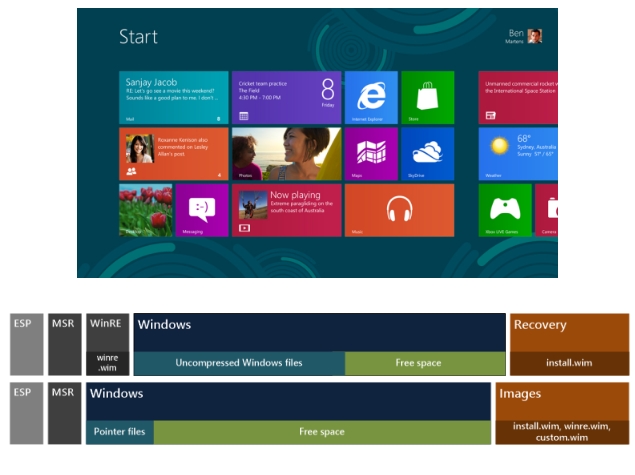- Home
- Tablets
- Tablets News
- Windows 8.1 will use compression to fit on 16GB devices
Windows 8.1 will use compression to fit on 16GB devices

Low-end devices typically have 1GB of RAM and 16GB of physical storage space, and that's the target Microsoft set for itself in order to compete with Android tablets. On a typical device, Windows 8.1 itself can take up to 9GB of space, leaving users with next to nothing left for installing software and saving files. However, Windows 8.1 with the recently released Update 1 can be made to occupy less than 4GB of space.
While the small footprint was announced with the release of Update 1, Microsoft has recently published a blog post and support documents describing the technique in more detail. "WIMBoot", or Windows Image Boot, uses a highly compressed version of the usual Windows file and folder structure, which resides in its own disk partition similar to the recovery partition on many devices. Users will still see a Windows folder, although entries in it are pointers to specific locations within the compressed partition, rather than the files themselves.
Users of existing Windows 8 or 8.1 devices will not be able to implement WIMBoot while updating, since it requires a fresh installation. Microsoft stresses that this is not a separate edition of Windows (like the Starter editions used to be), but is simply a new way of installing it.
There will be a slight performance hit due to the need to compress and decompress data on demand. WIMBoot requires solid-state storage, which allow for much faster non-sequential read and write speeds than traditional spinning hard drives. Devices must use either SSD or eMMC storage. Neither hard drives nor hybrids which combine spinning and solid-state tech are supported. Microsoft also warns that some backup, encryption and antivirus programs will encounter errors.
A modern UEFI (Unified Extensible Firmware Interface) BIOS is required to implement WIMBoot, but this is already a requirement for Windows 8 certification. New tablets with WIMBoot will launch soon, but system administrators can also create images for deployment to existing machines, including customised apps, drivers and branding.
Get your daily dose of tech news, reviews, and insights, in under 80 characters on Gadgets 360 Turbo. Connect with fellow tech lovers on our Forum. Follow us on X, Facebook, WhatsApp, Threads and Google News for instant updates. Catch all the action on our YouTube channel.
- Samsung Galaxy Unpacked 2025
- ChatGPT
- Redmi Note 14 Pro+
- iPhone 16
- Apple Vision Pro
- Oneplus 12
- OnePlus Nord CE 3 Lite 5G
- iPhone 13
- Xiaomi 14 Pro
- Oppo Find N3
- Tecno Spark Go (2023)
- Realme V30
- Best Phones Under 25000
- Samsung Galaxy S24 Series
- Cryptocurrency
- iQoo 12
- Samsung Galaxy S24 Ultra
- Giottus
- Samsung Galaxy Z Flip 5
- Apple 'Scary Fast'
- Housefull 5
- GoPro Hero 12 Black Review
- Invincible Season 2
- JioGlass
- HD Ready TV
- Laptop Under 50000
- Smartwatch Under 10000
- Latest Mobile Phones
- Compare Phones
- Realme P4x 5G
- OnePlus Ace 6T
- OPPO A6x 5G
- Samsung Galaxy Z TriFold
- Poco F8 Ultra
- Poco F8 Pro
- Huawei Mate 80 RS Master Edition
- Huawei Mate 80 Pro Max
- Asus ProArt P16
- MacBook Pro 14-inch (M5, 2025)
- Poco Pad M1
- Poco Pad X1
- Just Corseca Skywatch Pro
- Honor Watch X5
- Acerpure Nitro Z Series 100-inch QLED TV
- Samsung 43 Inch LED Ultra HD (4K) Smart TV (UA43UE81AFULXL)
- Asus ROG Ally
- Nintendo Switch Lite
- Haier 1.6 Ton 5 Star Inverter Split AC (HSU19G-MZAID5BN-INV)
- Haier 1.6 Ton 5 Star Inverter Split AC (HSU19G-MZAIM5BN-INV)












